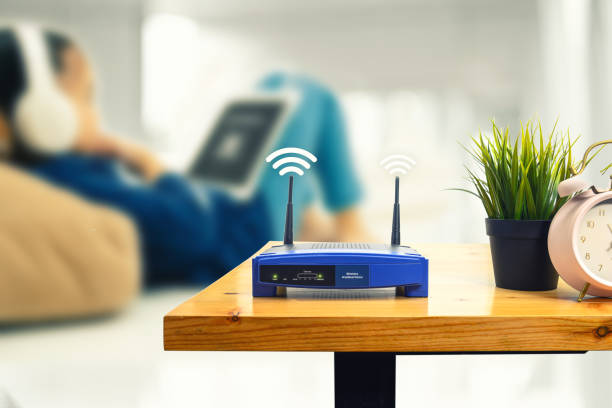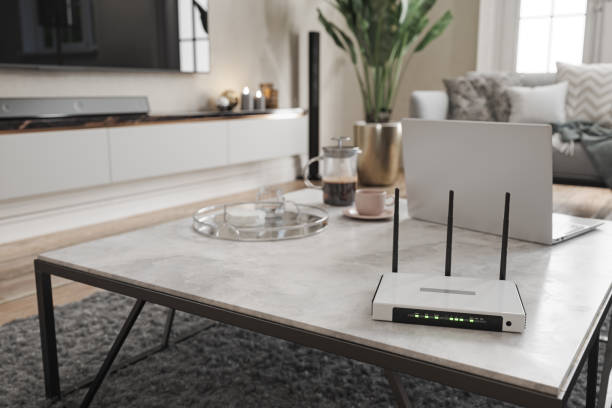In the digital age, where connectivity reigns supreme, the placement of your router plays a pivotal role in ensuring seamless internet access throughout your home. Gone are the days when routers were tucked away in a corner, hidden from sight. Today, understanding the best spot for your router is crucial for maximizing internet speed and reliability. Keep reading to learn more.
Introduction
The modern household is overburdened with smart devices, from smartphones and laptops to smart TVs and home automation systems. Each of these devices relies heavily on a stable internet connection, making the placement of your router a critical consideration.
Understanding the Significance of Optimal Router Placement
The location of your router can significantly crash the performance of your Wi-Fi network. Therefore, placing it in the wrong spot can lead to dead zones, slow speeds, and dropped connections. On the other hand, strategic placement can enhance coverage and minimize interference. It also makes sure that you have a smooth online experience for all your connected devices.
Factors to Consider When Choosing a Spot for Your Router
Well, when selecting the ideal spot for your router, several factors come into play to ensure optimal performance and coverage throughout your home. Here are some key considerations:
Proximity to Devices: Remember, the closer your router is to your devices, the stronger the Wi-Fi signal will be. That is why make sure that the router is centrally located within your home to minimize signal loss and dead zones.
Interference from Other Electronic Devices: Keep your router away from appliances like microwaves, cordless phones, and Bluetooth devices, as they can cause interference and disrupt Wi-Fi signals.
Structural Obstacles: Thick walls, metal surfaces, and large furniture can obstruct Wi-Fi signals and reduce coverage. Choose a spot for your router that is free from such obstacles to ensure maximum signal strength.
Signal Strength and Quality: Use a Wi-Fi analyzer or smartphone app to assess signal strength and quality in different areas of your home. This will help you identify potential dead zones and determine the best placement for your router.
Ventilation and Heat Dissipation: Routers can generate heat during operation, so it’s essential to place them in well-ventilated areas to prevent overheating. Avoid enclosing your router in cabinets or closets where airflow may be restricted.
Elevation: Elevating your router can improve signal propagation and reduce interference from nearby objects. Consider mounting the router on a wall or placing it on a high shelf for optimal coverage.
Accessibility for Maintenance: Choose a spot that allows easy access to the router for maintenance and troubleshooting purposes. Avoid placing it in hard-to-reach areas or behind furniture where it may be difficult to access.
By considering these factors, you can select the best spot for your router to ensure reliable Wi-Fi coverage and performance throughout your home.
Exploring Different Areas for Router Placement
When exploring different areas for router placement, it’s crucial to consider different options to optimize Wi-Fi coverage and signal strength throughout your home. Here are some areas that you should consider:
Central Location Within the Home: Place your router in a central area because it makes sure that Wi-Fi signals are evenly distributed throughout your home. This also helps minimize dead zones and ensures consistent connectivity across different rooms and floors.
Elevated Positions: Elevating your router can help improve signal propagation and reduce interference from obstacles like furniture and walls. Consider mounting the router on a wall or placing it on a high shelf to maximize coverage.
Avoiding Enclosed Spaces: Avoid placing your router in enclosed spaces like closets or cabinets, as this can restrict airflow and lead to overheating. Opt for open areas with adequate ventilation to ensure optimal router performance.
Near Main Living Areas: Try to position the router near the main living areas where most of your devices are used. It can help ensure reliable connectivity for activities like streaming, gaming, and video conferencing.
Away from Interference Sources: Keep your router away from sources of electromagnetic interference, such as cordless phones, microwaves, and Bluetooth devices. This helps minimize signal disruption and ensures stable Wi-Fi connections.
Testing Different Locations: Experiment with different areas for router placement to determine the optimal position for maximum coverage and signal strength. Use tools like Wi-Fi analyzers to assess signal quality in different areas of your home.
Consider External Factors: Factors like home layout, construction materials, and neighboring Wi-Fi networks can also impact router performance. Take these external factors into account when choosing a spot for your router.
By exploring these different areas for router placement and considering factors like centralization, elevation, ventilation, and interference, you can optimize Wi-Fi coverage and ensure a reliable internet connection throughout your home.

| Call 866-861-4084 for Internet Deals |
Tips for Improving Router Performance
Improving router performance is crucial for ensuring a seamless internet experience in your home. Here are some tips to enhance the performance of your router:
Use Wi-Fi Extenders or Mesh Systems: Wi-Fi extenders and mesh systems help amplify your router’s signal and extend coverage to areas with weak connectivity. By strategically placing these devices, you can eliminate dead zones and improve overall Wi-Fi performance.
Adjust Antenna Positioning: Many routers come equipped with adjustable antennas that allow you to fine-tune signal direction and strength. Experiment with antenna positioning to optimize coverage and minimize signal interference.
Implement Router Firmware Updates: Regular firmware updates provide bug fixes, security patches, and performance enhancements for your router. Check for updates regularly and install them to ensure your router operates at its best.
Optimize Channel Selection: Routers operate on different channels to transmit Wi-Fi signals. Use a Wi-Fi analyzer tool to identify the least congested channels in your area and adjust your router settings accordingly. This can help minimize interference from neighboring networks and improve Wi-Fi performance.
Limit the Number of Connected Devices: Too many connected devices can strain your router’s resources and lead to slower speeds and dropped connections. Limit the number of connected devices or invest in a router with higher capacity to accommodate your household’s needs.
Enable Quality of Service (QoS) Settings: Quality of Service settings allow you to prioritize certain types of internet traffic, such as gaming or streaming, over others. By enabling QoS settings on your router, you can ensure that important applications receive the necessary bandwidth for optimal performance.
Opt for Wired Connections: For devices that require high-speed and reliable connections, consider using wired Ethernet connections instead of Wi-Fi. This reduces wireless congestion and ensures consistent performance for activities like gaming or video streaming.
Position the Router Strategically: Place your router in a central location within your home to ensure equal coverage in all areas. Avoid placing it near thick walls, metal objects, or other electronic devices that can interfere with Wi-Fi signals
Common Mistakes to Avoid When Placing Your Router
When it comes to improving Wi-Fi performance, avoiding common mistakes in router placement can make a big difference. Here are some mistakes that you should avoid for better performance.
Placing the Router Near Thick Walls or Large Metal Objects:
Thick walls and metal surfaces can block or weaken Wi-Fi signals, leading to poor coverage and slow speeds. That is why avoid placing your router near these obstacles to ensure optimal signal strength throughout your home.
Keeping the Router in a Closed Cabinet:
Enclosed spaces like cabinets or closets can restrict airflow and cause your router to overheat. This can lead to performance issues and even hardware damage over time. Instead, place your router in an open area with adequate ventilation to maintain optimal temperature levels.
Ignoring Signal Interference:
Moreover, electronic devices like cordless phones, baby monitors, and microwave ovens can interfere with Wi-Fi signals and degrade performance. Be mindful of these devices and avoid placing your router near them to minimize interference and maintain a stable connection.
Neglecting Router Height:
Wi-Fi signals travel both horizontally and vertically, so the height at which you place your router can impact coverage. Elevate your router to a higher position, such as on a shelf or mounted on a wall, to improve signal propagation and reduce interference from obstacles on the ground.
Overlooking Router Placement During Setup:
During the basic setup of your router, take the time to experiment with different placement options to find the optimal position for maximum coverage and performance. Test signal strength in various areas of your home and adjust the router’s position accordingly.
Positioning the Router in a Corner:
Placing your router in a corner of your home limits its coverage area and may result in uneven signal distribution. Instead, position the router in a central location to maximize coverage and ensure consistent connectivity across all areas of your home.

Failing to Consider Home Layout:
Every home is unique, and factors like layout, size, and construction materials can influence Wi-Fi performance. Consider these factors when choosing a spot for your router and be willing to adapt based on the specific needs of your home environment.
Conclusion
The placement of your router is paramount in optimizing Wi-Fi performance and ensuring reliable internet connectivity throughout your home. By considering factors like proximity to devices, interference from other electronic devices, and structural obstacles, you can find the ideal spot to set up your router and enjoy seamless online experiences.
FAQs
How can I test the signal strength in different areas of my home?
You can use smartphone apps or Wi-Fi analyzers to measure signal strength and identify potential dead zones.
Is it necessary to upgrade my router for better performance?
In some cases, upgrading to a newer router with advanced features can improve performance, especially in larger homes or those with many connected devices.
Can I use multiple routers to extend Wi-Fi coverage in my home?
Yes, you can set up additional routers as access points or use mesh Wi-Fi systems to extend coverage and improve signal strength.
What should I do if I experience slow Wi-Fi speeds despite optimal router placement?
Try troubleshooting steps like rebooting your router, updating firmware, or contacting your internet service provider for assistance.
Are there any DIY methods for improving Wi-Fi coverage at home?
Yes, you can try DIY solutions like building homemade reflectors or using aluminum foil to direct Wi-Fi signals towards specific areas.

Meet Jennifer Harper, a wordsmith extraordinaire who has been shaping the digital landscape with her creative prowess for the past two years. Not just a content writer; she is a storyteller who brings the content to life. Her passion for internet trends, memes, and the ever-evolving world of entertainment is evident in every piece she creates. Jennifer doesn’t just follow trends; she sets them.